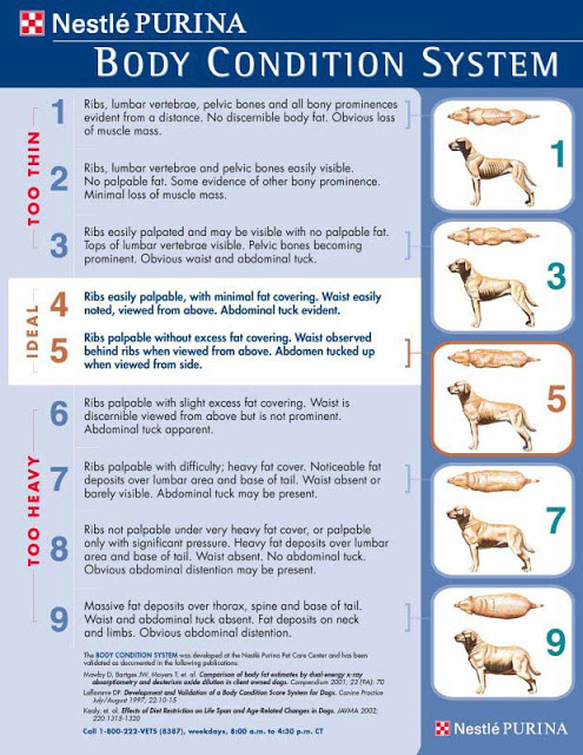Obesity in Pets
Obesity is a growing problem in cats and dogs. A recent study found that 50% of America's cat and dogs are overweight! Just like in people, obesity causes (or worsens) many problems including arthritis, diabetes and a shorter life expectancy. We know it's hard to avoid those big, begging eyes at dinner time, but there are many good medical reasons to cut back on the cookies! Here at Bayfield Animal Hospital, we believe strongly in helping pets achieve and keep a healthy weight. Is your pet less active than they used to be? Are you noticing your dog or cat breathing harder with normal exercise? Bring your pet in today for an evaluation of their body condition! We can help you put together a plan to reach a healthy weight and stay there!
How do we grade weight in pets? How can we judge a tiny chihuahua compared to a giant St. Bernard compared to a cat? We use a Body Condition Scoring (BCS) system to compare dogs and cats of all sizes. The scale looks at a few factors:
Here is an example of one of the scoring systems we use for dogs. We use a similar system for cats.
Obesity is a growing problem in cats and dogs. A recent study found that 50% of America's cat and dogs are overweight! Just like in people, obesity causes (or worsens) many problems including arthritis, diabetes and a shorter life expectancy. We know it's hard to avoid those big, begging eyes at dinner time, but there are many good medical reasons to cut back on the cookies! Here at Bayfield Animal Hospital, we believe strongly in helping pets achieve and keep a healthy weight. Is your pet less active than they used to be? Are you noticing your dog or cat breathing harder with normal exercise? Bring your pet in today for an evaluation of their body condition! We can help you put together a plan to reach a healthy weight and stay there!
How do we grade weight in pets? How can we judge a tiny chihuahua compared to a giant St. Bernard compared to a cat? We use a Body Condition Scoring (BCS) system to compare dogs and cats of all sizes. The scale looks at a few factors:
- Are the ribs easily felt from the side?
- Is there an obvious waist when looked at from above?
- Is there a visible 'tummy' tuck from the side?
Here is an example of one of the scoring systems we use for dogs. We use a similar system for cats.
Where does your pet fit on the scale? We're happy to help you decide, and put together a plan to hit that "5" together!
Plans to lose weight can include:
Plans to lose weight can include:
- Increased exercise. The type and length of exercise depends on your pet's overall health. We can put together a plan for your pet that will be safe and effective.
- Decreased calories. We can help you determine how much and what to feed to help your pet lose weight.
- Careful selection of treats. Check out this "Treat Translator" - how many cheese burgers does a single cheese cube equal when fed to a dog?
www.hillspet.com/weight-management/human-food-translator.html - Sometimes, changing to a low fat or weight-loss food can help. We can prescribe a special diet that is formatted for weight loss. More information about that diet can be found here:
http://www.youtube.com/watch?v=wioHDWZFH5Y



